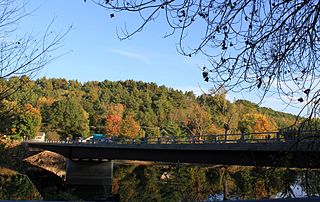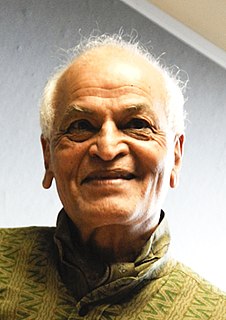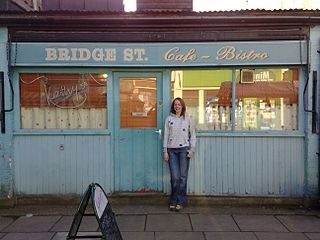Related Research Articles

The Book of Numbers is the fourth book of the Hebrew Bible, and the fourth of five books of the Jewish Torah. The book has a long and complex history; its final form is possibly due to a Priestly redaction of a Yahwistic source made some time in the early Persian period. The name of the book comes from the two censuses taken of the Israelites.

John Muir also known as "John of the Mountains" and "Father of the National Parks", was an influential Scottish-American naturalist, author, environmental philosopher, botanist, zoologist, glaciologist, and early advocate for the preservation of wilderness in the United States of America.

Milton is a town in Chittenden County, Vermont, United States. The population was 10,352 at the 2010 census. According to local legend, the town was named for the English poet John Milton, but the name most likely originated from William FitzWilliam, 4th Earl FitzWilliam, who held the title Viscount Milton and was a supporter of independence for the colonies during the American Revolution.

Howard Harold Hanson was an American composer, conductor, educator, music theorist, and champion of American classical music. As director for 40 years of the Eastman School of Music, he built a high-quality school and provided opportunities for commissioning and performing American music. In 1944, he won a Pulitzer Prize for his Symphony No. 4, and received numerous other awards including the George Foster Peabody Award for Outstanding Entertainment in Music in 1946.

Wilderness or wildlands, are natural environments on Earth that have not been significantly modified by human activity or any nonurbanized land not under extensive agricultural cultivation. The term has traditionally referred to terrestrial environments, though growing attention is being placed on marine wilderness. Recent maps of wilderness suggest it covers roughly one quarter of Earth's terrestrial surface, but is being rapidly degraded by human activity. Even less wilderness remains in the ocean, with only 13.2% free from intense human activity.

Satish Kumar is an Indian British activist and speaker. He has been a Jain monk, nuclear disarmament advocate and pacifist. Now living in England, Kumar is founder and Director of Programmes of the Schumacher College international centre for ecological studies, and is Editor Emeritus of Resurgence & Ecologist magazine. His most notable accomplishment is the completion, together with a companion, E. P. Menon, of a peace walk of over 8,000 miles in 1973–4, from New Delhi to Moscow, Paris, London, and Washington, D.C., the capitals of the world's earliest nuclear-armed countries. He insists that reverence for nature should be at the heart of every political and social debate.

The Allagash River is a tributary of the Saint John River, approximately 65 miles (105 km) long, in northern Maine in the United States. It drains in a remote and scenic area of wilderness in the Maine North Woods north of Mount Katahdin. The name "Allagash" comes from the Abenaki language, a dialect of the Algonquin languages, spoken by the Penobscot Tribe. The word, /walakéskʸihtəkʸ/, means "bark stream".

Charles Bridgeman (1690–1738) was an English garden designer who helped pioneer the naturalistic landscape style. Although he was a key figure in the transition of English garden design from the Anglo-Dutch formality of patterned parterres and avenues to a freer style that incorporated formal, structural and wilderness elements, Bridgeman's innovations in English landscape architecture have been somewhat eclipsed by the work of his more famous successors, William Kent and Lancelot "Capability" Brown.

Walford is a fictional borough of east London in the BBC soap opera EastEnders. It is the primary setting for the soap. EastEnders is filmed at Borehamwood in Hertfordshire, towards the north-west of London. Much of the location work is filmed in nearby Watford, which was chosen for many of the exterior scenes due to its close proximity and the town's name being so similar to Walford. Thus, any stray road signs or advertising boards which are accidentally filmed in the back of shots will appear to read Walford. Locations used in Watford include most interior and exterior church scenes of various churches, the snooker club, the County Court and Magistrates' Courts courtrooms, and the cemetery.

Norwood Russell Hanson was an American philosopher of science. Hanson was a pioneer in advancing the argument that observation is theory-laden — that observation language and theory language are deeply interwoven — and that historical and contemporary comprehension are similarly deeply interwoven. His single most central intellectual concern was the comprehension and development of a logic of discovery.

Harold John Massingham (25 March 1888 – 22 August 1952) was a prolific British writer on ruralism, matters to do with the countryside and agriculture. He was also a published poet.

Arkaroola is the common name for the Arkaroola Wilderness Sanctuary, a wildlife sanctuary situated on 610 square kilometres of freehold and pastoral lease land in South Australia. It is located 700 kilometres north of the Adelaide city centre in the Northern Flinders Ranges, adjacent to the Vulkathunha-Gammon Ranges National Park and the Mawson Plateau. The most common way to get there is by car, but air travel can be chartered from Parafield Airport, Adelaide Airport or Aldinga Airfield. It was used as a location set for the 2002 film The Tracker.
Mike Tomkies, known as The Wilderness Man, was a British author covering subjects such as natural history, biography and fiction, a naturalist and filmmaker who has inspired thousands with his brutally honest accounts of almost 40 years experience living in the wildest and most remote parts of Canada, Scotland and Spain.

Robert Michael Pyle is an American lepidopterist, writer, teacher, and founder of the Xerces Society for Invertebrate Conservation. Much of his life story is told in the 2020 feature film The Dark Divide, where Pyle is played by David Cross.

Sespe Creek is a stream, some 61 miles (98 km) long, in Ventura County, southern California, in the Western United States. The creek starts at Potrero Seco in the eastern Sierra Madre Mountains, and is formed by more than thirty tributary streams of the Sierra Madre and Topatopa Mountains, before it empties into the Santa Clara River in Fillmore.
John P. Milton is a meditation and Qigong instructor, author, and environmentalist. He is the founder of Sacred Passage and the Way of Nature.

The Anglo-Corsican Kingdom was a client state of the Kingdom of Great Britain that existed on the island of Corsica between 1794 and 1796, during the French Revolutionary Wars.

Elcor is a ghost town, or more properly, an extinct town, in the U.S. state of Minnesota that was inhabited between 1897 and 1956. It was built on the Mesabi Iron Range near the city of Gilbert in St. Louis County. Elcor was its own unincorporated community before it was abandoned and was never a neighborhood proper of the city of Gilbert. Not rating a figure in the national census, the people of Elcor were only generally considered to be citizens of Gilbert. The area where Elcor was located was annexed by Gilbert when its existing city boundaries were expanded after 1969.

Audubon Sharon, which consists of the Sharon Audubon Center and the Emily Winthrop Miles Wildlife Sanctuary, is a wildlife sanctuary of the National Audubon Society in Sharon, Connecticut. The 1,147 acres (464 ha) of the Sharon Audubon Center property is primarily forest land with two ponds with 11 miles (18 km) of trails for visitors to use. Its facilities include a raptor aviary, an herb garden, a garden to attract bird and butterflies, a sugarhouse, a memorial room to Hal Borland, a small museum and store. Sharon Audubon Center is located at 325 Cornwall Bridge Road.
Robert Alexander Gilbert was an African-American nature photographer. Gilbert was a helper and field assistant to ornithologist William Brewster from 1896 or 1897 until Brewster's death in 1919 and was later employed at the Museum of Comparative Zoology at Harvard. His photographic work while employed by Brewster went uncredited until the publication of a book-length biography on Gilbert by John Hanson Mitchell, Looking for Mr. Gilbert: The Unlikely Life of the First African American Landscape Photographer.
References
- ↑ "Archived copy". Archived from the original on 2016-05-21. Retrieved 2016-05-16.CS1 maint: archived copy as title (link)
- ↑ Mitchell, John Hanson (August 6, 2013). Ceremonial Time: 15,000 Years on One Square Mile. UPNE. p. 256. ISBN 978-1611684889.
- ↑ Mitchell, John Hanson (April 3, 1985). A Field Guide to Your Own Back Yard: A Seasonal Guide to Flora and Fauna of the Eastern U.S. Countryman Press. p. 288. ISBN 0881504742.
- ↑ Mitchell, John Hanson (April 1, 2014). Living at the End of Time. UPNE. p. 240. ISBN 978-1611685886.
- ↑ Mitchell, John Hanson (March 11, 1997). Walking Towards Walden: A Pilgrimage in Search of Place . Counterpoint. p. 320. ISBN 0201154870.
- ↑ Mitchell, John Hanson (May 2002). The Wildest Place on Earth: Italian Gardens and the Invention of Wilderness. Counterpoint. p. 208. ISBN 1582432155.
- ↑ Mitchell, John Hanson (April 1, 1998). Trespassing: An Inquiry into the Private Ownership of Land. Diane Pub Co. p. 291. ISBN 0788190911.
- ↑ Mitchell, John Hanson (December 28, 2006). Looking for Mr. Gilbert: The Reimagined Life of an African American . Counterpoint. pp. 288. ISBN 1593761422.
- ↑ Mitchell, John Hanson (November 25, 2008). The Rose Café: Love and War in Corsica . Counterpoint. p. 256. ISBN 978-1582434452.
- ↑ Mitchell, John Hanson (June 1, 2009). The Paradise of All These Parts: A Natural History of Boston. Beacon Press. p. 272. ISBN 978-0807071496.
- ↑ Mitchell, John Hanson (May 1, 2012). The Last of the Bird People. Wilderness House Press. p. 184.
- ↑ Mitchell, John Hanson (June 3, 2013). An Eden of Sorts: The Natural History of My Feral Garden. Countryman Press. p. 200. ISBN 978-1581571721.
- ↑ Mitchell, John Hanson (January 2, 2015). Stray Leaves. Massachusetts Audubon Society. p. 150. ISBN 9780986386916.